Distribution of Hyperpycnal Flow Related Sandstone Deposits in a Lacustrine Shale System: Implication for Hydrocarbon Reservoir Exploration in the Chang 7 Oil Member of the Triassic Yanchang Formation, Ordos Basin, China
Abstract
:1. Introduction
2. Geological Setting
3. Data and Methods
4. Results
4.1. Deposition Characteristics of the Deep-Water Sandstone
4.1.1. Sedimentary Facies
4.1.2. Facies Interpretation from the Cores
4.2. Distribution of the Hyperpycnal Flow Related Sandstone
5. Discussion
5.1. Oil Reservoir Distribution in Hyperpycnal Flow Related Sandstone
5.2. Oil Production of Hyperpycnites Related Reservoirs
6. Conclusions
- The hyperpycnal flow deposition was developed in the Chang 7 member of Yanchang Formation in Bazhu area, southwest Ordos Basin. There are several lithofacies types, such as parallel bedded fine sandstone (Sh), massive bedded fine sandstone (Sm), massive bedded fine sandstone with mud clasts (Smg), deformed bedded siltstone (Fd), wave-lenticular bedded siltstone (Fh), and black shale (M). Inside, three facies of hyperpycnal channel, levee and deep lacustrine facies can be identified;
- The extrabasinal turbidity flows of the Chang 7 member developed in deep and semi-deep lacustrine environment. Influenced by the fluvial supply from southwest of the basin, the sediments were plunged into the lake basin. The hyperpycnal flow deposits in Chang 72 and Chang 71 were developed in a large area. The complex turbidite channel sand body is the main position of sandstone development in the black shale background environment;
- The development of the sand body of Chang 7 increased gradually, and the sand body of Chang 71 was the main position of sandy hyperpycnites. The fine description of the sand body indicated a channelized sedimentary pattern. The thick sandy hyperpycnites mainly developed in the middle of those channels, and the eastern part of the study area is the main deposition position of the hyperpycnal flow deposits;
- From the analysis of the actual well data, the distribution range and scale of high-quality reservoirs are controlled by the sedimentary characteristics of those sand bodies generated by the hyperpycnal flow. The sedimentary dynamic and facies belt could be the main reason for the sandstone variation of hyperpycnites. From the perspective of plane overlap and single well analysis, the thick sand body is the favorable position for the development of an oil reservoir, which has a significant control effect on the reservoir scale and oil production.
Author Contributions
Funding
Data Availability Statement
Conflicts of Interest
References
- Yang, R.C.; Li, Z.F.; Zhang, X.C.; Ci, X.H.; Fang, X.Q.; Li, C.H.; Liu, H.N. Advances and perspectives in the study of hyperpycnal flow deposition. Acta Sedimentol. Sin. 2023, 27, 65–75. [Google Scholar]
- Feng, Z.Z. Words of the Editor-in-Chief: Some ideas about the comments and discussions of hyperpycnal flows and hyperpycnites. J. Palaeogeogr. 2019, 8, 25. [Google Scholar] [CrossRef]
- Mulder, T.; Syvitski, J.P.M. Turbidity currents generated at river mouths during exceptional discharges to the world oceans. J. Geol. 1995, 103, 285–299. [Google Scholar] [CrossRef]
- Steel, E.; Simms, A.R.; Steel, R.; Olariu, C. Hyperpycnal delivery of sand to the continental shelf: Insights from the Jurassic Lajas Formation, Neuquén Basin, Argentina. Sedimentology 2018, 65, 2149–2170. [Google Scholar] [CrossRef]
- Van Loon, A.J.; Hüneke, H.; Mulder, T. The hyperpycnite problem: Comment. J. Palaeogeogr. 2019, 8, 24. [Google Scholar] [CrossRef]
- Wright, L.D.; Yang, Z.S.; Bornhold, B.D.; Keller, G.H.; Prior, D.B.; Wiseman, W.J., Jr. Hyperpycnal plumes and plume fronts over the Huanghe (Yellow River) delta front. Geo-Mar. Lett. 1986, 6, 97–105. [Google Scholar] [CrossRef]
- Zavala, C.; Arcuri, M. Intrabasinal and extrabasinal turbidites: Origin and distinctive characteristics. Sediment. Geol. 2016, 337, 36–54. [Google Scholar] [CrossRef]
- He, Q.X. A discussion on sediment dynamics. Mar. Geol. Quat. Geol. 2010, 30, 1–10. [Google Scholar] [CrossRef]
- Niu, X.B.; Yang, T.; Cao, Y.C.; Li, S.X.; Zhou, X.P.; Xi, K.L. Characteristics and formation mechanisms of gravity-flow deposits in a lacustrine depression basin: Examples from the Late Triassic Chang 7 oil member of the Yanchang Formation, Ordos Basin, Central China. Mar. Pet. Geol. 2022, 148, 106048. [Google Scholar] [CrossRef]
- Fan, A.P.; Yang, R.C.; Van Loon, A.J.; Yin, W.; Han, Z.Z.; Zavala, C. Classification of gravity-flow deposits and their significance for unconventional petroleum exploration, with a case study from the Triassic Yanchang Formation (southern Ordos Basin, China). J. Asian Earth Sci. 2018, 161, 57–73. [Google Scholar] [CrossRef]
- Liu, F.; Zhu, X.M.; Li, Y.; Xu, L.M.; Niu, X.B.; Zhu, S.F.; Liang, X.W.; Xue, M.G.; He, J.C. Sedimentary characteristics and facies model of gravity flow deposits of Late Triassic Yanchang Formation in southwestern Ordos Basin, NW China. Pet. Explor. Dev. 2015, 42, 577–588. [Google Scholar] [CrossRef]
- Liang, X.W.; Xian, B.Z.; Feng, S.B.; Chen, P.; You, Y.; Wu, Q.R.; Dan, W.D.; Zhang, W.M. Architecture and Main Controls of Gravity-flow Sandbodies in Chang 7 Member, Longdong Area, Ordos Basin. Acta Sedimentol. Sin. 2022, 40, 641–652. [Google Scholar]
- Dou, L.X.; Best, J.; Bao, Z.D.; Hou, J.G.; Zhang, L.; Liu, Y.M. The sedimentary architecture of hyperpycnites produced by transient turbulent flows in a shallow lacustrine environment. Sediment. Geol. 2020, 411, 105804. [Google Scholar] [CrossRef]
- Liao, J.J.; Zhu, X.M.; Deng, X.Q.; Sun, B.; Hui, X. Sedimentary characteristics and model of gravity flow in Triassic Yanchang Formation of Longdong Area in Ordos Basin. Earth Sci. Front. 2013, 20, 29–39. [Google Scholar]
- Forel, F.A. Les Ravins Sous-Lacustres Des Fleuves Glaciaires; Gauthier-Villars: Paris, France, 1885. [Google Scholar]
- Bates, C.C. Rational theory of delta Formation. AAPG Bull. 1953, 37, 2119–2162. [Google Scholar]
- Lowe, D.R. Sediment gravity flows: II. Depositional models with special reference to the deposits of high-density turbidity currents. J. Sediment. Res. 1982, 52, 279–297. [Google Scholar]
- Wright, L.D.; Wiseman, W.J.; Bornhold, B.D.; Prior, D.B.; Suhayda, J.N.; Keller, G.H.; Yang, Z.-S.; Fan, Y.B. Marine dispersal and deposition of Yellow River silts by gravity-driven underflows. Nature 1988, 332, 629–632. [Google Scholar] [CrossRef]
- Zavala, C.; Jose, J.; Arcuri, M.; Drittanti, D.; Freije, H.; Asensio, M. Ancient lacustrine hyperpycnites: A depositional model from a case study in the rayoso Formation (Cretaceous) of west-central Argentina. J. Sediment. Res. 2006, 76, 41–59. [Google Scholar] [CrossRef]
- Soyinka, O.A.; Slatt, R.M. Identification and micro-stratigraphy of hyperpycnites and turbidites in Cretaceous Lewis Shale, Wyoming. Sedimentology 2008, 55, 1117–1133. [Google Scholar] [CrossRef]
- Zavala, C. Hyperpycnal (over density) flows and deposits. J. Palaeogeogr. 2020, 9, 17. [Google Scholar] [CrossRef]
- Shanmugam, G. The hyperpycnite problem. J. Palaeogeogr. 2018, 7, 6. [Google Scholar] [CrossRef]
- Mulder, T.; Syvitski, J.P.M.; Migeon, S.; Faugères, J.-C.; Savoye, B. Marine hyperpycnal flows: Initiation, behavior and related deposits. Mar. Pet. Geol. 2003, 20, 861–882. [Google Scholar] [CrossRef]
- Mutti, E.; Tinterri, R.; Benevelli, G.; di Biase, D.; Cavanna, G. Deltaic, mixed and turbidite sedimentation of ancient foreland basins. Mar. Pet. Geol. 2003, 20, 733–755. [Google Scholar] [CrossRef]
- Yang, T.; Cao, Y.C.; Wang, Y.Z.; Zhang, S.M.; Zhang, H.N.; Wang, S.J. Sediment dynamics process and sedimentary characteristics of hyperpycnal flows. Geol. Rev. 2015, 61, 23–33. [Google Scholar]
- He, T.H.; Li, W.H.; Lu, S.F.; Yang, E.Q.; Jing, T.T.; Ying, J.F.; Zhu, P.F.; Wang, X.Z.; Pan, W.Q.; Zhang, B.S.; et al. Quantitatively unmixing method for complex mixed oil based on its fractions carbon isotopes: A case from the Tarim Basin, NW China. Pet. Sci. 2023, 20, 102–113. [Google Scholar] [CrossRef]
- Yang, R.C.; Jin, Z.J.; Sun, D.S.; Fan, A.P. Discovery of hyperpycnal flow deposits in the Late Triassic Lacustrine Ordos Basin. Acta Sedimentol. Sin. 2015, 33, 10–20. [Google Scholar]
- Zou, C.N.; Feng, Y.L.; Yang, Z.; Jiang, W.Q.; Zhang, T.S.; Zhang, H.; Wang, X.N.; Zhu, J.C.; Wei, Q.Z. Fine-grained gravity flow sedimentation and its influence on development of shale oil sweet intervals in lacustrine basins in China. Pet. Explor. Dev. 2023, 50, 1–15. [Google Scholar]
- Zou, C.N.; Zhao, Z.Z.; Yang, H.; Fu, J.H.; Zhu, R.K.; Yuan, X.J.; Wang, L. Genetic mechanism and distribution of sandy debris flows in terrestrial lacustrine basin. Acta Sedimentol. Sin. 2009, 27, 1065–1075. [Google Scholar]
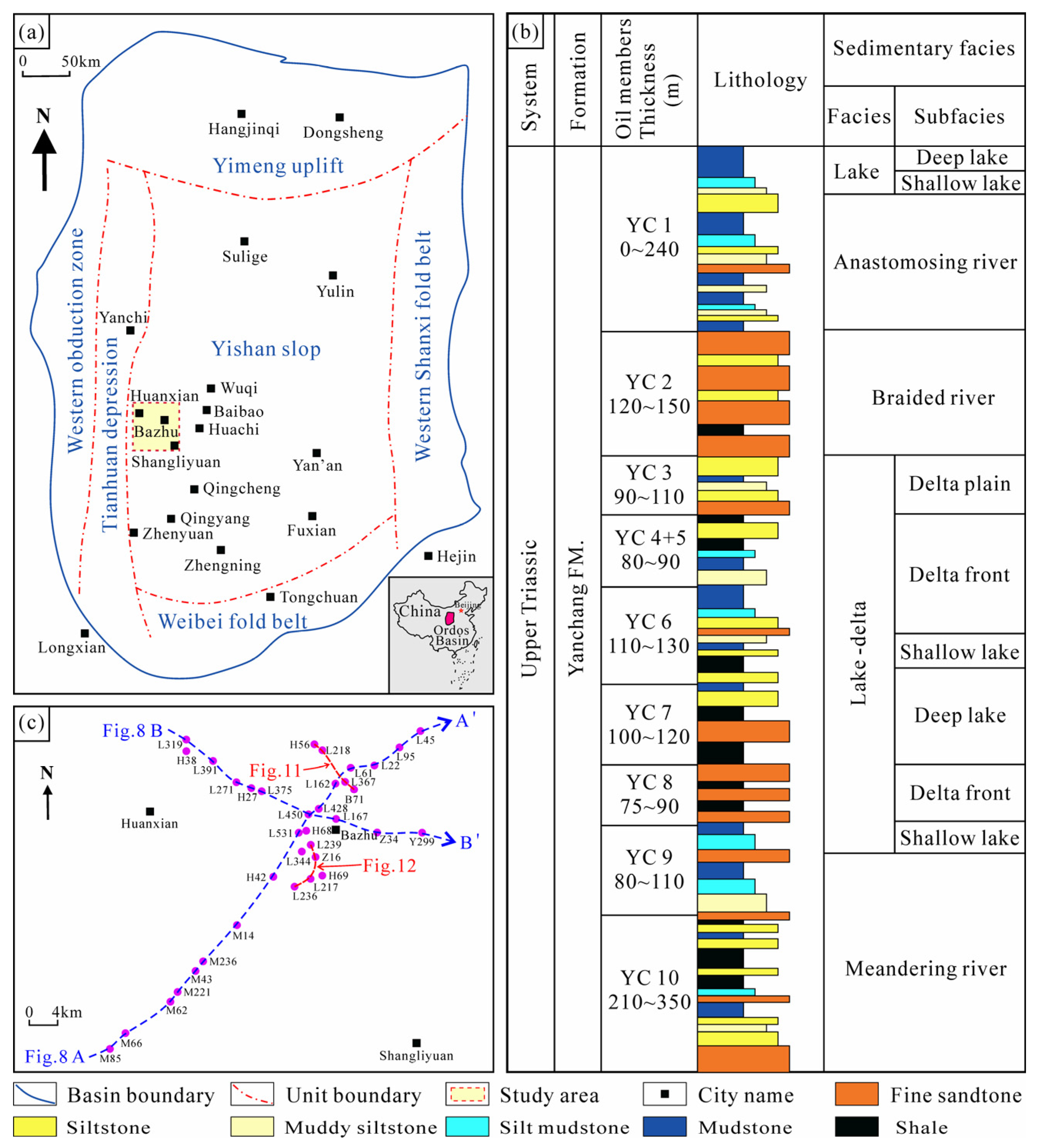
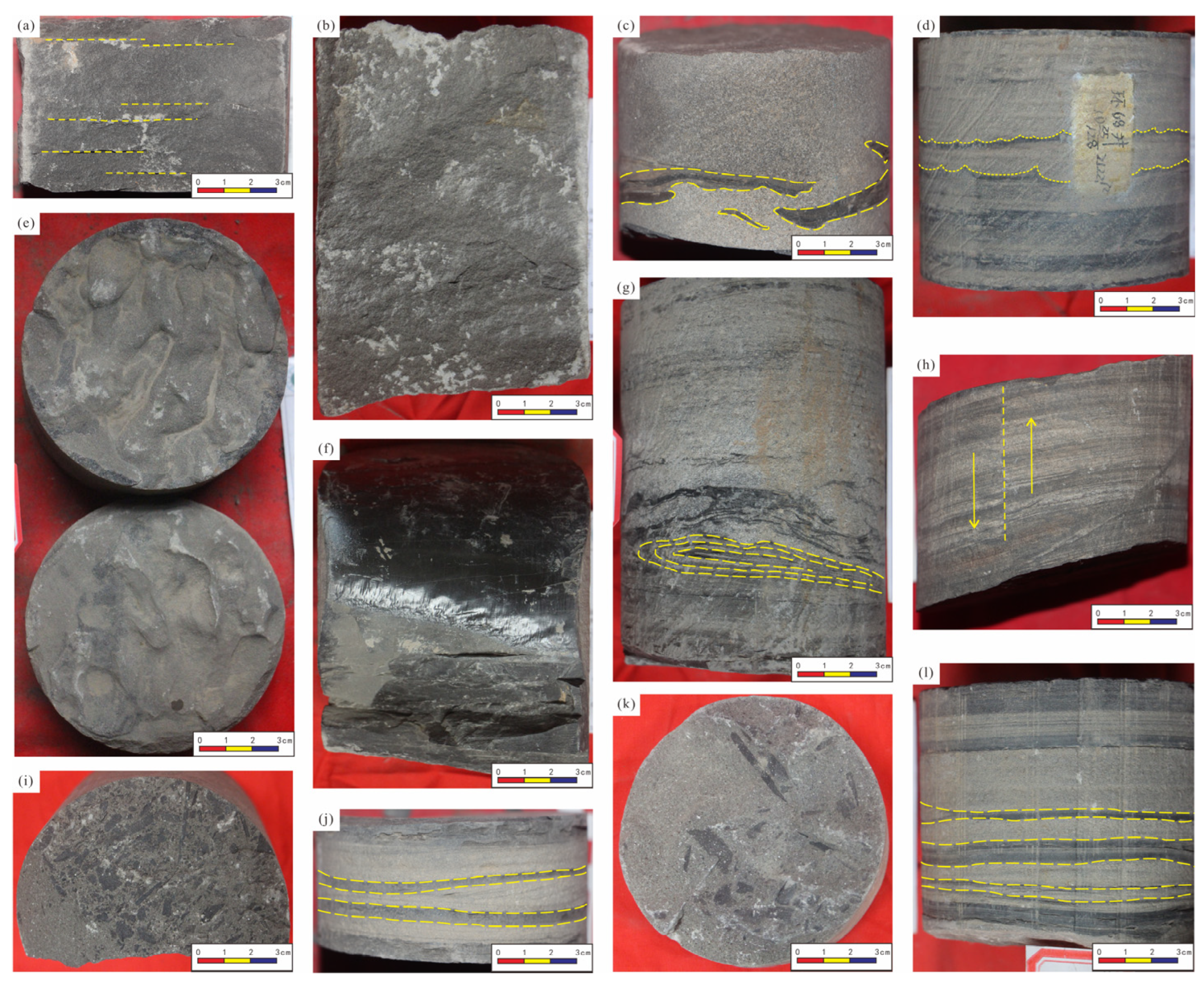

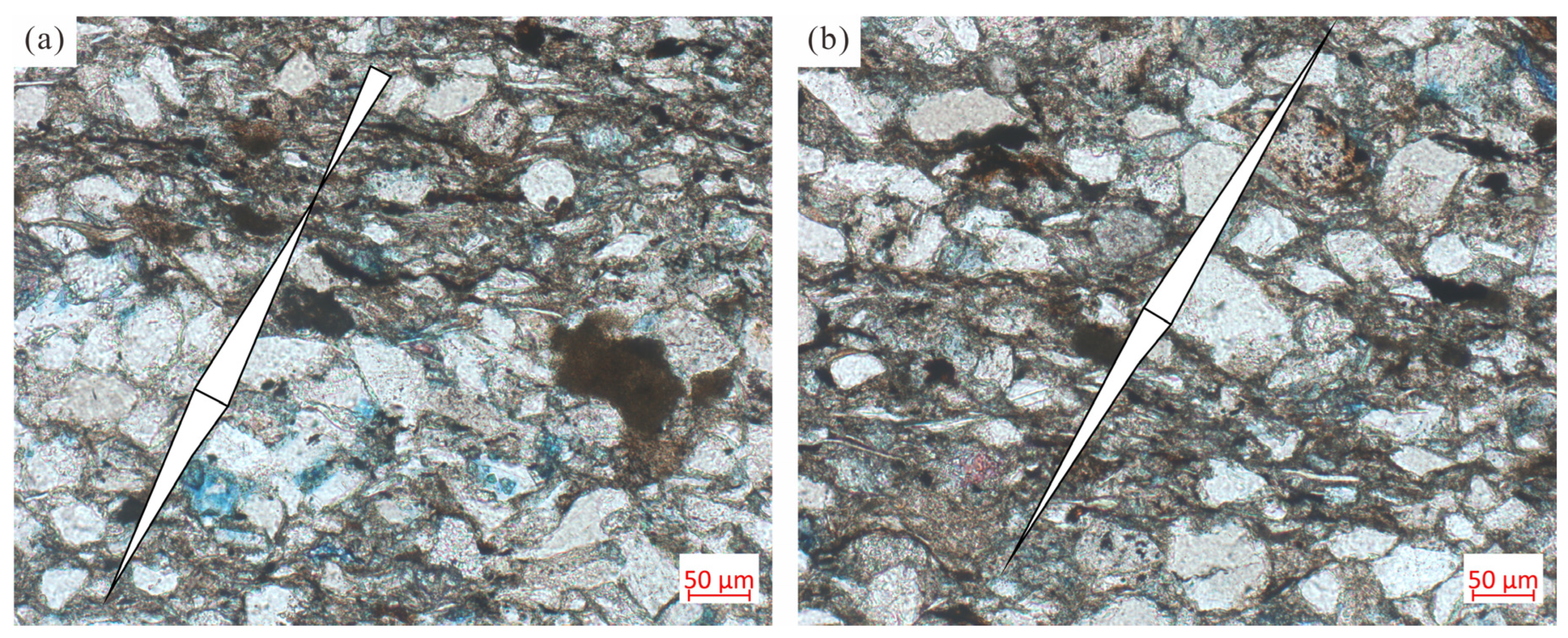
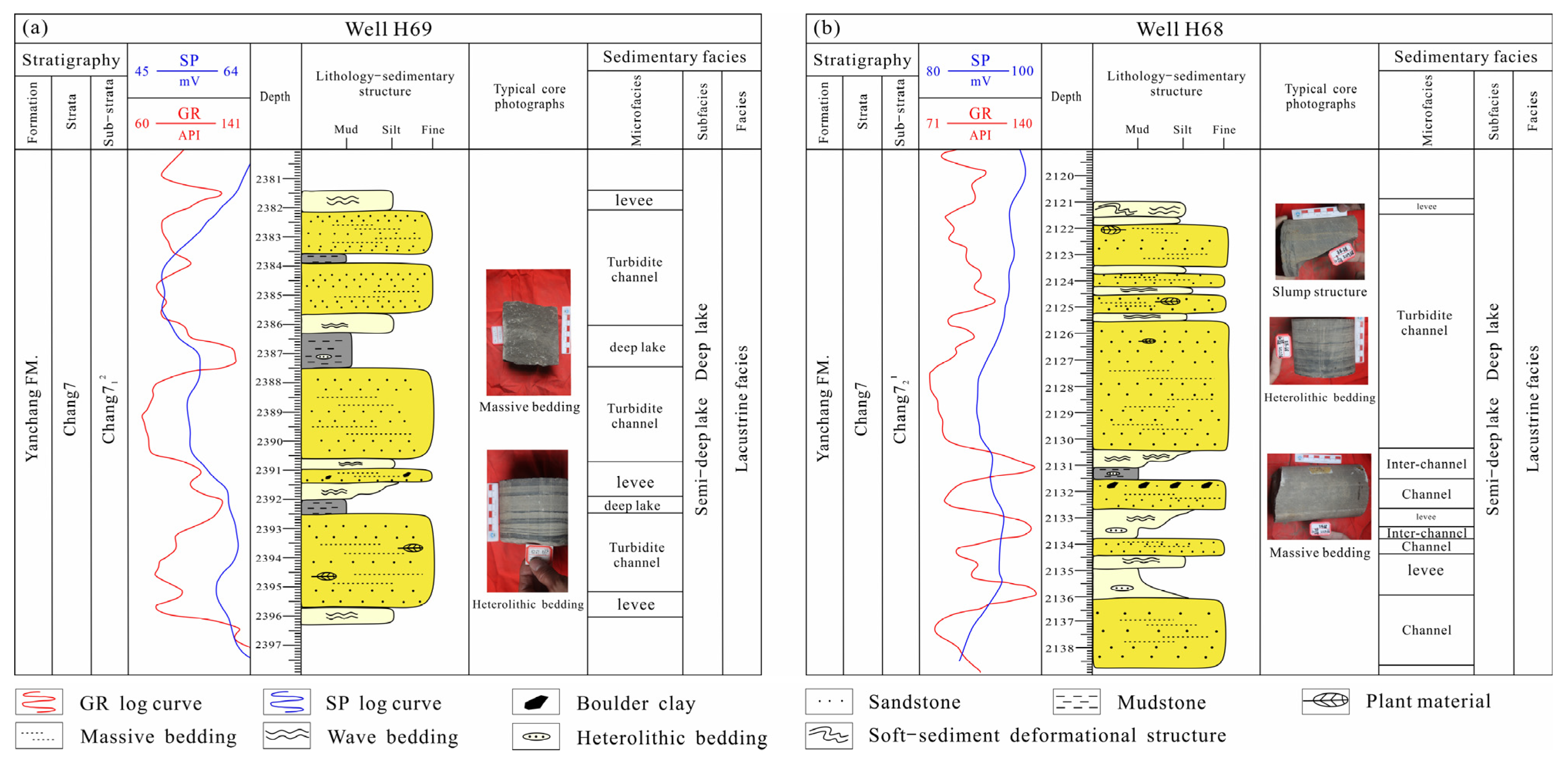

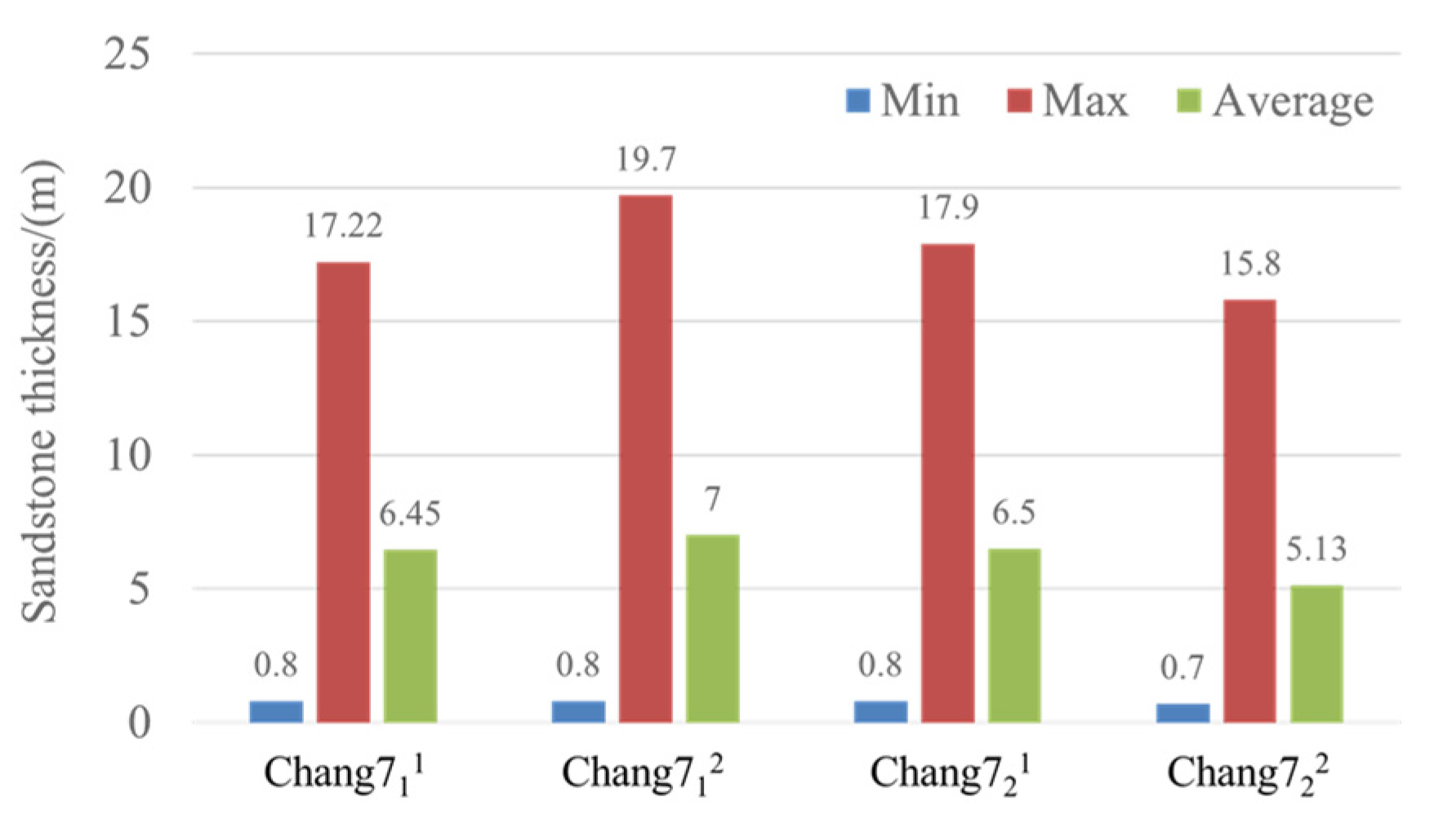

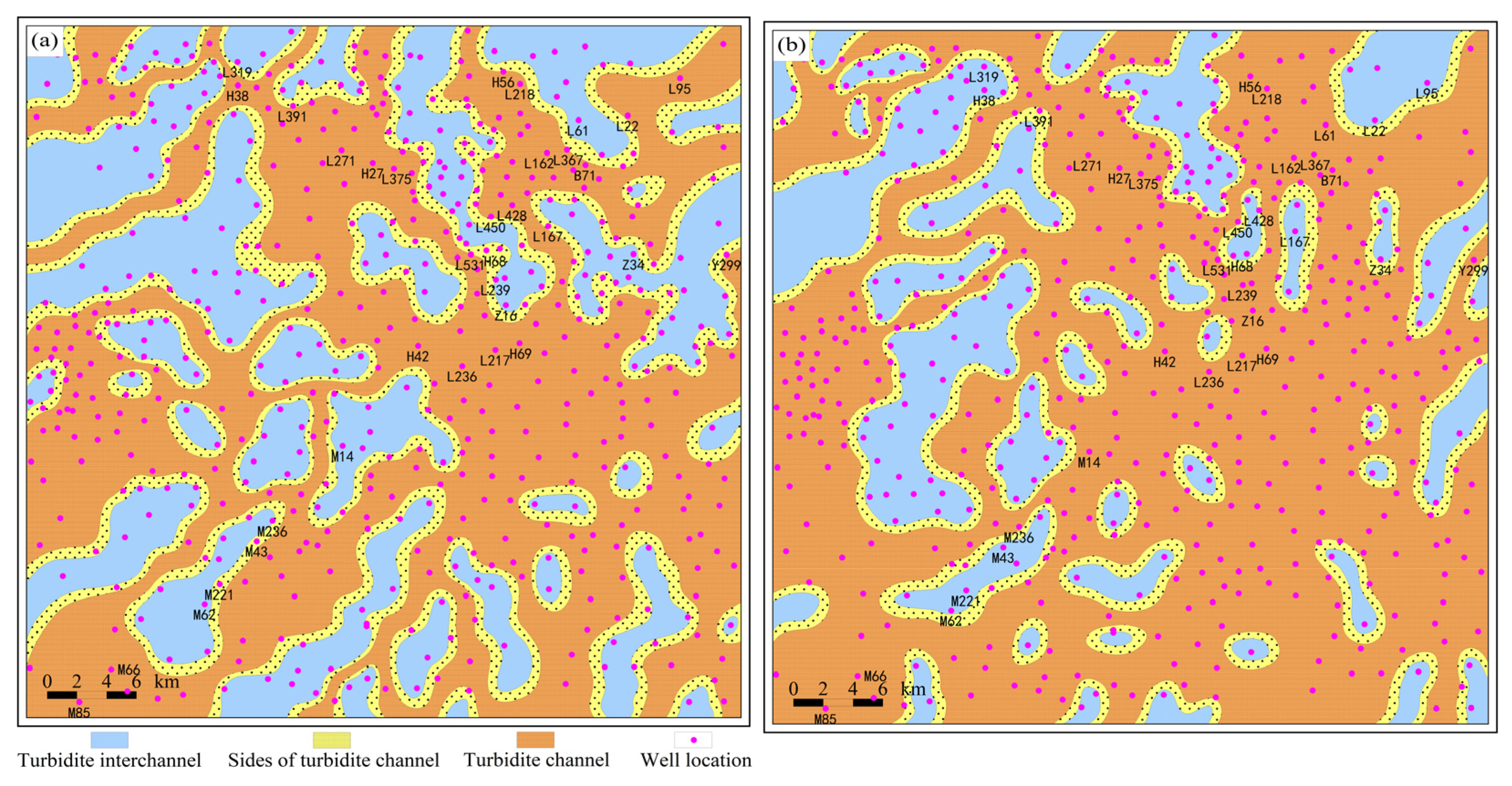
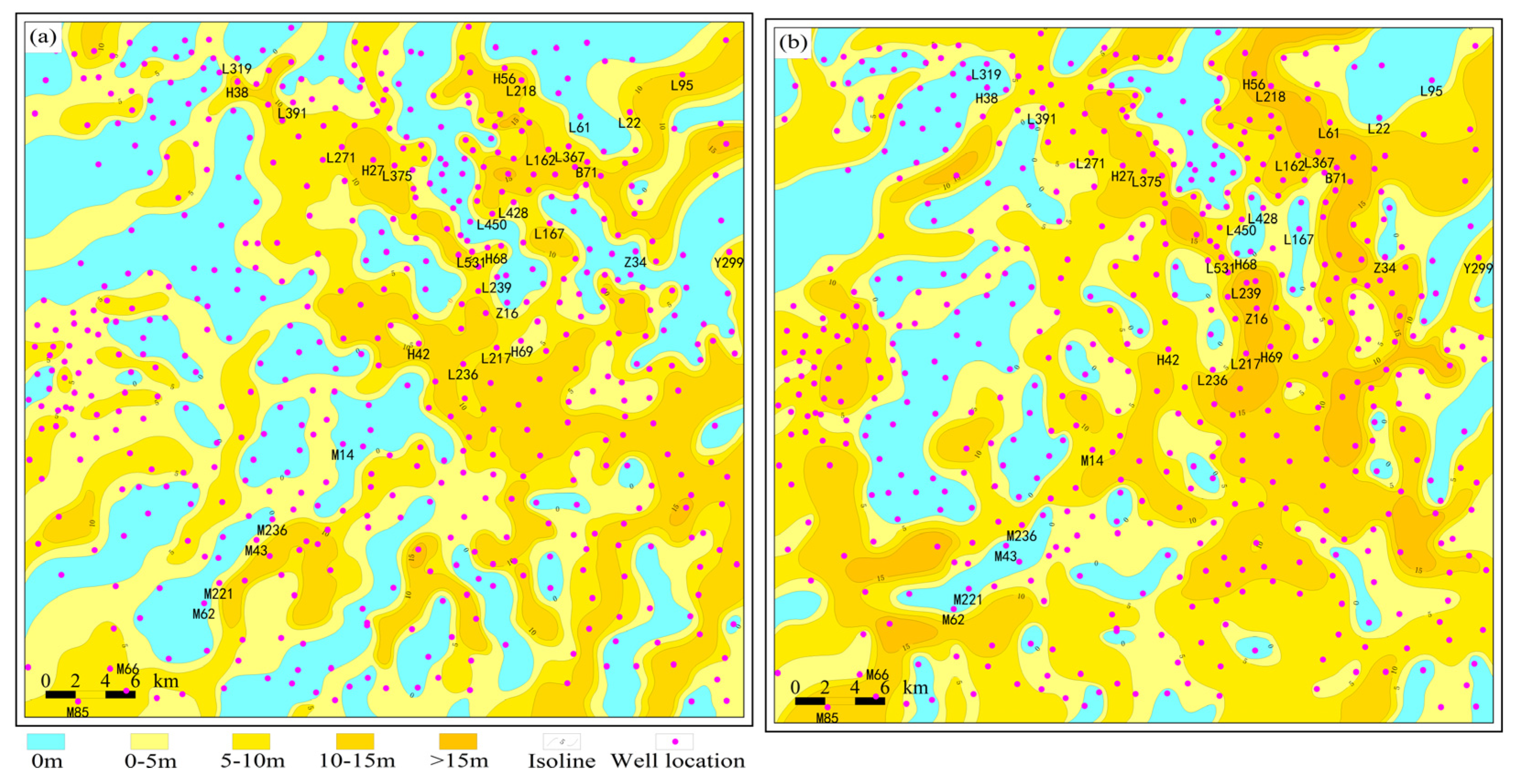
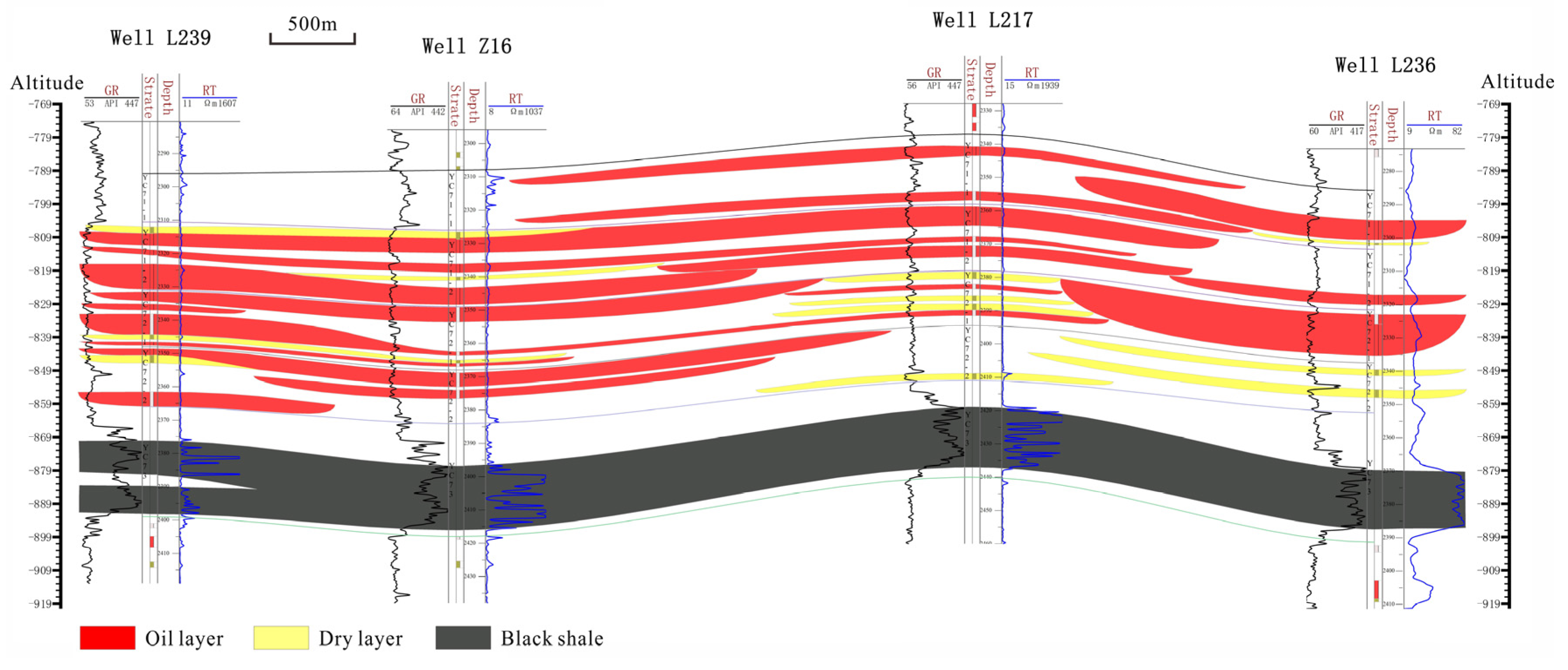
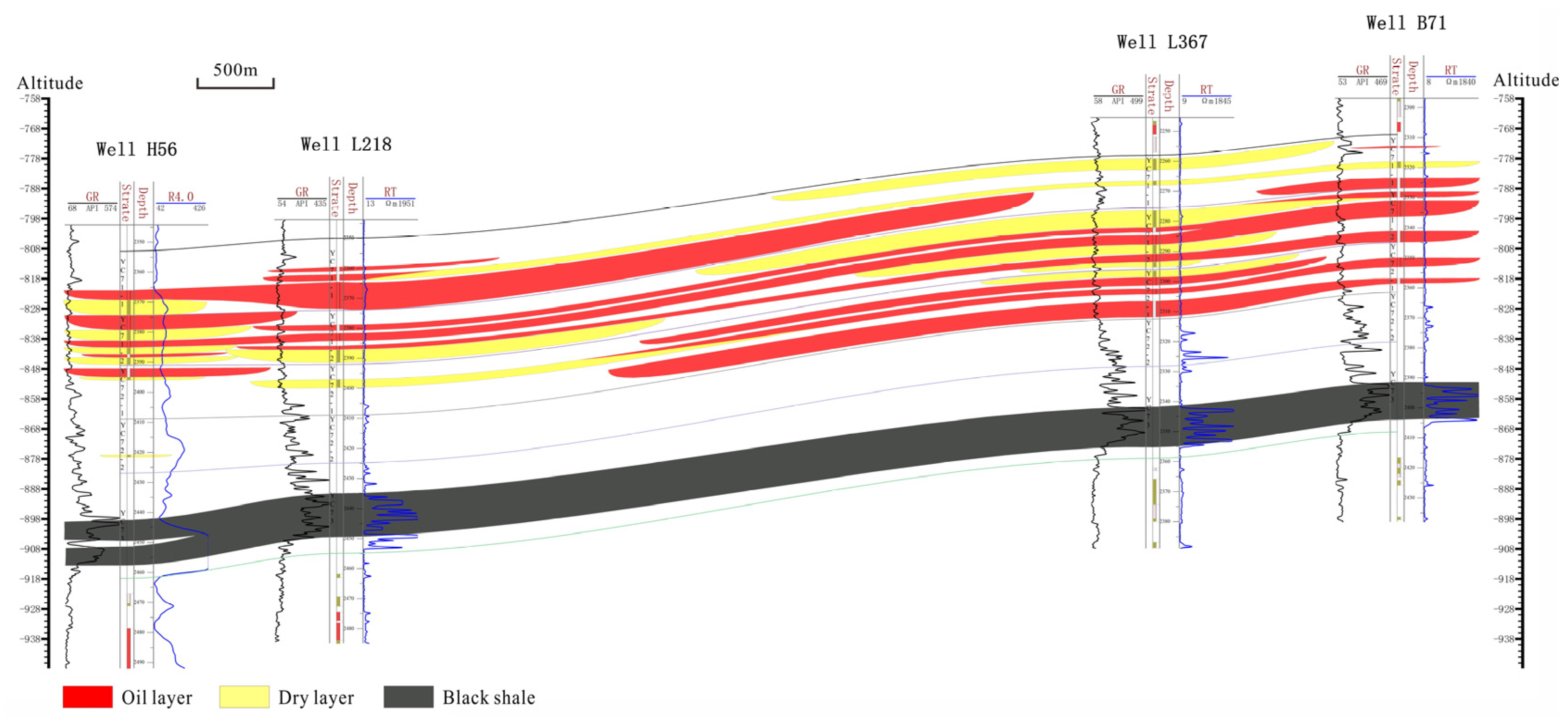
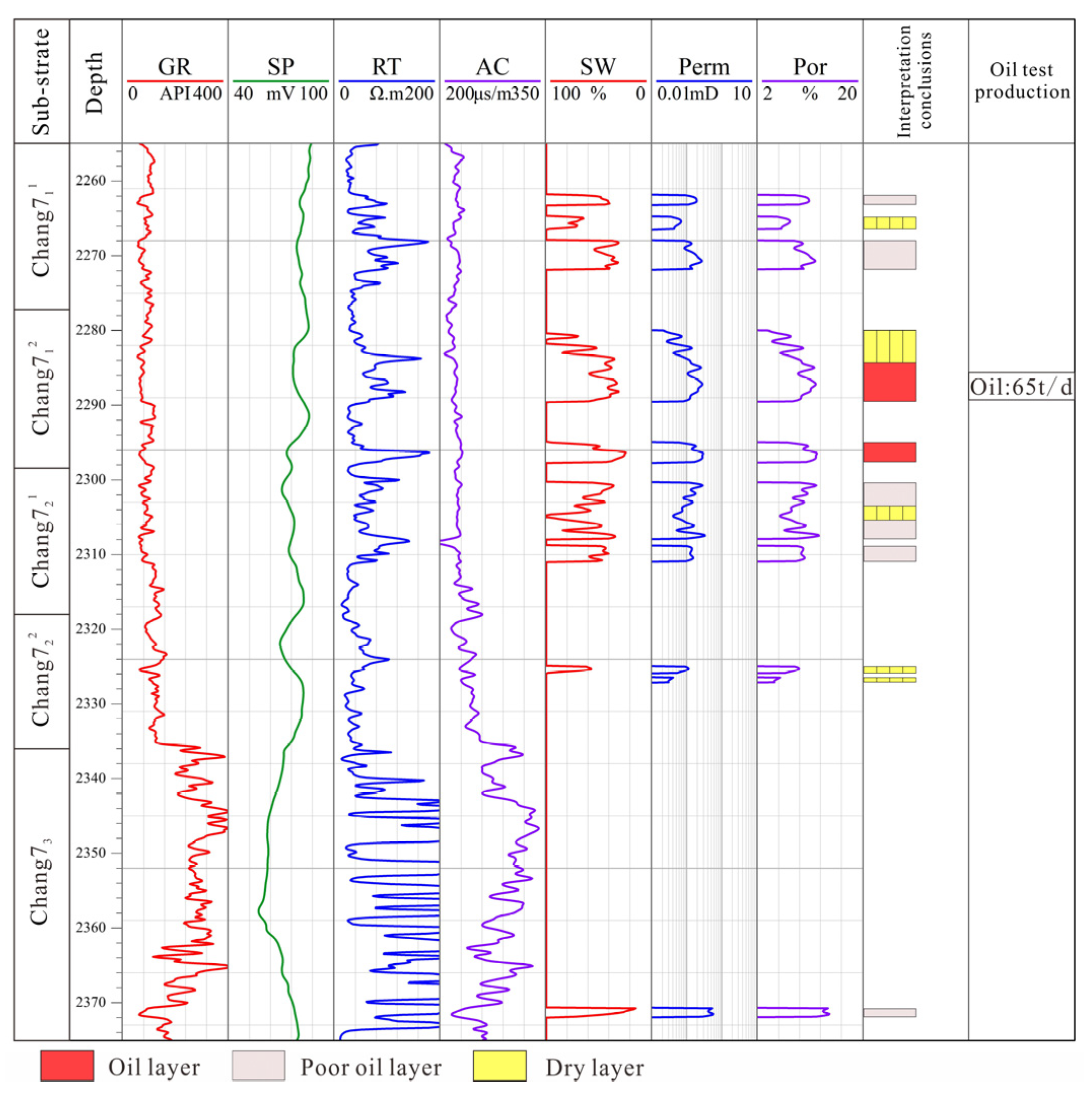

Disclaimer/Publisher’s Note: The statements, opinions and data contained in all publications are solely those of the individual author(s) and contributor(s) and not of MDPI and/or the editor(s). MDPI and/or the editor(s) disclaim responsibility for any injury to people or property resulting from any ideas, methods, instructions or products referred to in the content. |
© 2023 by the authors. Licensee MDPI, Basel, Switzerland. This article is an open access article distributed under the terms and conditions of the Creative Commons Attribution (CC BY) license (https://creativecommons.org/licenses/by/4.0/).
Share and Cite
Sun, P.; Zhao, L.; Ma, Q.; Zhang, W.; Zhang, S.; Li, X.; Wen, J.; Dou, L.; Wen, Z. Distribution of Hyperpycnal Flow Related Sandstone Deposits in a Lacustrine Shale System: Implication for Hydrocarbon Reservoir Exploration in the Chang 7 Oil Member of the Triassic Yanchang Formation, Ordos Basin, China. Processes 2023, 11, 2642. https://doi.org/10.3390/pr11092642
Sun P, Zhao L, Ma Q, Zhang W, Zhang S, Li X, Wen J, Dou L, Wen Z. Distribution of Hyperpycnal Flow Related Sandstone Deposits in a Lacustrine Shale System: Implication for Hydrocarbon Reservoir Exploration in the Chang 7 Oil Member of the Triassic Yanchang Formation, Ordos Basin, China. Processes. 2023; 11(9):2642. https://doi.org/10.3390/pr11092642
Chicago/Turabian StyleSun, Pengyu, Lixia Zhao, Qian Ma, Wei Zhang, Shun Zhang, Xiao Li, Juan Wen, Luxing Dou, and Zhigang Wen. 2023. "Distribution of Hyperpycnal Flow Related Sandstone Deposits in a Lacustrine Shale System: Implication for Hydrocarbon Reservoir Exploration in the Chang 7 Oil Member of the Triassic Yanchang Formation, Ordos Basin, China" Processes 11, no. 9: 2642. https://doi.org/10.3390/pr11092642
APA StyleSun, P., Zhao, L., Ma, Q., Zhang, W., Zhang, S., Li, X., Wen, J., Dou, L., & Wen, Z. (2023). Distribution of Hyperpycnal Flow Related Sandstone Deposits in a Lacustrine Shale System: Implication for Hydrocarbon Reservoir Exploration in the Chang 7 Oil Member of the Triassic Yanchang Formation, Ordos Basin, China. Processes, 11(9), 2642. https://doi.org/10.3390/pr11092642







